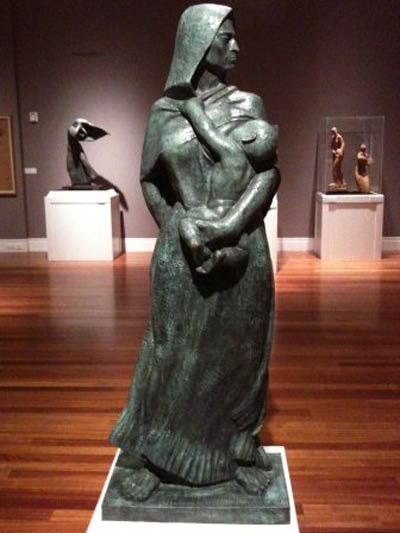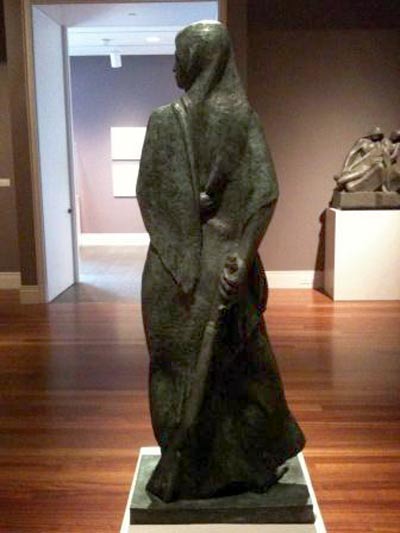
 Sculpture News at SculptSite.com
Sculpture News at SculptSite.com
Enrique Alferez Sculpture |
| NOLA.com By Doug MacCash, The Times-Picayune Critic reviews Enrique Alferez exhibit at the Ogden Museum"The Created World of Enrique Alferez," on display at the Ogden Museum of Southern Art, proves that the Art Deco sculptor's legacy will live long into the future. Add the soul-satisfying sculpture and drawing show, which closes April 2, to your must-do list. Alferez, born in Mexico in 1901, trained at the Art Institute of Chicago, then settled in New Orleans in 1929 where he became the city's most celebrated public artist. He died in 1999, his career having spanned most of the modern art movement as well as most of modern history, for that matter. That became mind-blowingly apparent as I spoke to his daughter, Dr. Tlaloc S. Alferez, about the Ogden exhibit, consisting mostly of works from her private collection. One particularly striking bronze sculpture from 1970, titled "La Soldadera," depicts a severe-looking woman clutching a baby to her breast with one hand as she hides a rifle behind her back with the other. When her father was just 12 years old, Tlaloc Alferez explained, he joined the legendary Pancho Villa's revolutionary army, gathering wood and water for the women who fed the soldiers. Her father told her that the women behind the battle line - like the straight-spined mother depicted in the sculpture - were the backbone of the Mexican Revolution. Sometimes, he told her, they joined in the fighting. By the time I met Alferez in the late 1980s, he was the grand old man of the New Orleans art scene, a tiny, bent figure in a beret who embodied the romantically rebellious bohemian era that had come before. Everyone knew that he'd produced heroic statues and friezes in City Park, at the old Lakefront Airport, Charity Hospital and elsewhere, many dating as far back as the Great Depression. Everyone admired him, even if his charmingly streamlined style had fallen far out of fashion. Fast forward a quarter-century. I'm walking amid Alferez's sculptures at the Ogden, and the world has changed yet again. A lot of the art that I so admired back in the '80s now seems quaint at best and absolutely silly at worst. But Alferez has retained his dignity. The bravery, sadness, anger and eroticism that he earnestly sought to communicate seem especially acute and authentic now. The Alferez show is no place to search for the self-defensive irony that has characterized much of contemporary art for the past 25 years. Neither is the Ogden exhibit a place to search for incomprehensible abstraction. In some ways, Alferez was a traditionalist, but he obviously adored futuristic geometry. Just look at the way the sway of the lute player's skirt perfectly echoes the shape of the instrument. Look at the smooth triangles, circles and rectangles that underlie most of the designs. Alferez's sculptures are elegantly simplified in the extreme; they are examples of Renaissance anatomy blended with rocket ship aerodynamics. Despite the abundant stylishness, they are never self-indulgent. Alferez obviously wanted us to perfectly understand his intentions. His daughter said he had no respect for art that required a lot of explanation. Art changes. Tastes change. A decade into the 21st century, Alferez's sculpture has achieved a certain timelessness. One of my last stops in reporting this story was the New Orleans Lakefront Airport, where I wandered around the base of Alferez's "The Fountain of the Four Winds," which contains a quartet of notoriously nude human figures. In the 1930s, a few onlookers were appalled by the frankness of the design. Tlaloc Alferez says that when the sculpture was first unveiled, her dad slept beside it with a rifle at his side to protect his work from the threat of vandalism. As I circled the forgotten fountain - which deserves restoration - I was struck by the fact that even now, the unmistakable symbolic and sexual energy of the scene is still as stirring as, well, the wind. The artist's passion and audacity still shine through the mineral deposits, weeds and wasp nests that add a patina of age to the dry fountain. Alferez, it appears, was not content with a mere 98 years on Earth, he seems to bid for artistic immortality. |
 I never met Enrique Alferez, but everytime I see one of his mmasterful works I think I know him... some sculptors through the ages seem to have a look and/or feeling to their work that enconses them in our minds throughout time. Enrique Alferez is one of those sculptors. A great read by Doug MacCash of The Times-Picayune! The Created World of Enrique Alferez |
 "La Soldadera" by Enrique Alferez Courtesy The Ogden Museum of Southern Art |
 "La Soldadera" by Enrique Alferez Courtesy The Ogden Museum of Southern Art |
More Sculpture News ....
Submit your SCULPTURE NEWS.
It's easy, just send us an e-mail
(click on Submit News in the left menu) with your pertinent information along with images, we'll take care of the rest. Sculpture makes our world a much better place in so many ways!
SculptSite.com, along with Sculptors and their creative genius all helping to bring the beauty and message of Sculpture to a hurried world.


